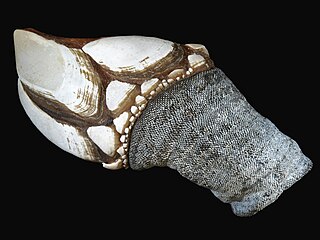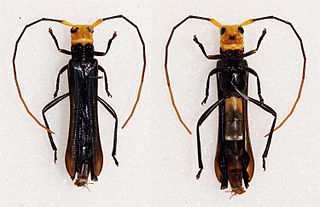
Goose barnacles, also called stalked barnacles or gooseneck barnacles, are filter-feeding crustaceans that live attached to hard surfaces of rocks and flotsam in the ocean intertidal zone. Goose barnacles formerly made up the taxonomic order Pedunculata, but the group has been found to be polyphyletic, with its members scattered across multiple orders of the infraclass Thoracica.

Thoracica is an infraclass of crustaceans which contains the most familiar species of barnacles found on rocky coasts, such as Semibalanus balanoides and Chthamalus stellatus. They have six well-developed limbs, and may be either stalked or sessile. The carapace is heavily calcified. The group includes free-living and commensal species.

Scytodes thoracica is a spitting spider, so called because it spits a venomous sticky silken substance over its prey. Its size ranges between 3–6 mm (0.12–0.24 in). The carapace is unusual in sloping upwards towards its rear end, whereas the abdomen slopes downwards.

The spotted bush warbler is a species of Old World warbler in the family Locustellidae. It is found in the northern Himalayas, Yunnan and central China, in the countries of Bangladesh, Bhutan, China, India, Myanmar and Nepal. Its natural habitat is arboreal forests.

Laphria is a genus described by Johann Wilhelm Meigen in 1803, belonging to the family Asilidae, subfamily Laphriinae. Members of this genus are known as bee-like robber flies. This genus has a Holarctic distribution, occurring in Europe, Asia, and North America. They prey on a variety of insects, including other robber flies, bees, wasps and beetles. Like other asilids, they use their proboscis to penetrate the body of their prey and inject enzymes which dissolve the tissues.

Saperdini is a tribe of longhorn beetles of the subfamily Lamiinae.

Neonitocris is a genus of longhorn beetles of the subfamily Lamiinae, containing the following species:
Neonitocris atra is a species of beetle in the family Cerambycidae. It was described by Karl Jordan in 1894.

Neonitocris princeps is a species of beetle in the family Cerambycidae. It was described by Karl Jordan in 1894, originally under the genus Nitocris. It has a wide distribution in Africa.
Neonitocris regina is a species of beetle in the family Cerambycidae. It was described by Karl Jordan in 1894.
Neonitocris gaboniensis is a species of beetle in the family Cerambycidae. It was described by Stephan von Breuning in 1956.
Neonitocris infrarufa is a species of beetle in the family Cerambycidae. It was described by Stephan von Breuning in 1956.
Neonitocris sibutensis is a species of beetle in the family Cerambycidae. It was described by Stephan von Breuning in 1956.
Neonitocris spiniscapus is a species of beetle in the family Cerambycidae. It was described by Stephan von Breuning in 1956.
Neonitocris calva is a species of beetle in the family Cerambycidae. It was described by James Thomson in 1868.
Neonitocris emarginata is a species of beetle in the family Cerambycidae. It was described by Chevrolat in 1858.
Neonitocris mangenoti is a species of beetle in the family Cerambycidae. It was described by Lepesme and Stephan von Breuning in 1953.
Neonitocris plicata is a species of beetle in the family Cerambycidae. It was described by Hintz in 1919.
Neonitocris rubriventris is a species of beetle in the family Cerambycidae. It was described by Hintz in 1919.
Sepsis thoracica, more commonly known as the black scavenger fly, a species of fly from the genus Sepsis and the family Sepsidae. It was discovered by Robineau-Desvoidy in 1830. It resembles a small flying ant. The fly is most commonly found inhabiting cow dung.






